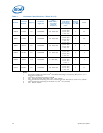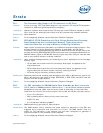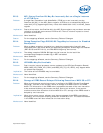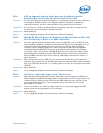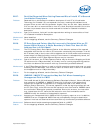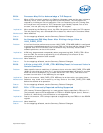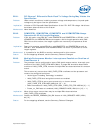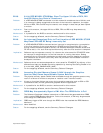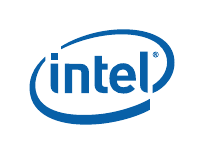
28 Specification Update
BV24. Changing the Memory Type for an In-Use Page Translation May Lead
to Memory-Ordering Violations
Problem: Under complex microarchitectural conditions, if software changes the memory type for
data being actively used and shared by multiple threads without the use of semaphores
or barriers, software may see load operations execute out of order.
Implication: Memory ordering may be violated. Intel has not observed this erratum with any
commercially available software.
Workaround: Software should ensure pages are not being actively used before requesting their
memory type be changed.
Status: For the steppings affected, see the Summary Tables of Changes.
BV25. Reported Memory Type May Not Be Used to Access the VMCS and
Referenced Data Structures
Problem: Bits 53:50 of the IA32_VMX_BASIC MSR report the memory type that the processor
uses to access the VMCS and data structures referenced by pointers in the VMCS. Due
to this erratum, a VMX access to the VMCS or referenced data structures will instead
use the memory type that the MTRRs (memory-type range registers) specify for the
physical address of the access.
Implication: Bits 53:50 of the IA32_VMX_BASIC MSR report that the WB (write-back) memory type
will be used but the processor may use a different memory type.
Workaround: Software should ensure that the VMCS and referenced data structures are located at
physical addresses that are mapped to WB memory type by the MTRRs.
Status: For the steppings affected, see the Summary Tables of Changes.
BV26. LBR, BTM or BTS Records May have Incorrect Branch From
Information After an EIST/T-state/S-state/C1E Transition or Adaptive
Thermal Throttling
Problem: The “From” address associated with the LBR (Last Branch Record), BTM (Branch Trace
Message) or BTS (Branch Trace Store) may be incorrect for the first branch after a
transition of:
• EIST (Enhanced Intel® SpeedStep Technology)
• T-state (Thermal Monitor states)
• S1-state (ACPI package sleep state)
• C1E (Enhanced C1 Low Power state)
• Adaptive Thermal Throttling
Implication: When the LBRs, BTM or BTS are enabled, some records may have incorrect branch
“From” addresses for the first branch after a transition of EIST, T-states, S-states, C1E,
or Adaptive Thermal Throttling.
Workaround: None identified.
Status: For the steppings affected, see the Summary Tables of Changes.



